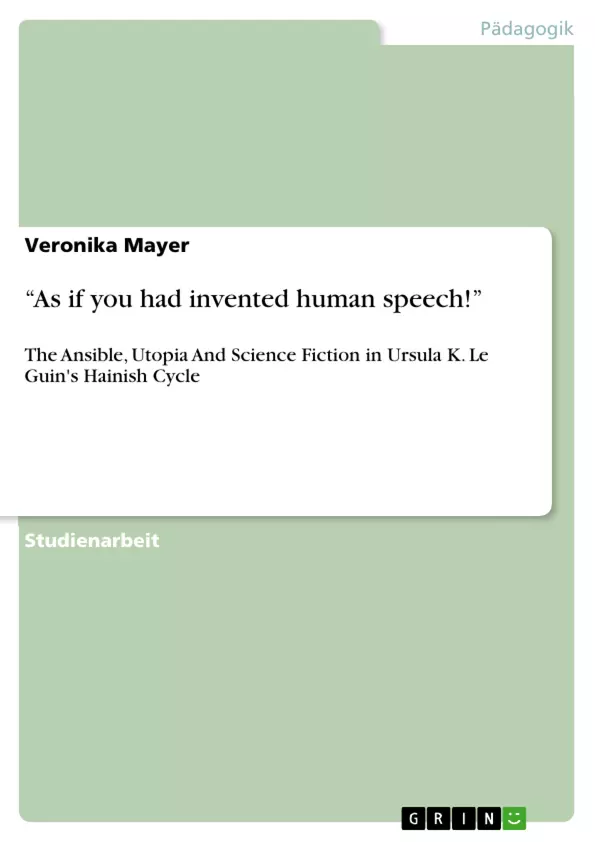In 1979, Barry N. Malzberg remarks about Ursula K. Le Guin that “she is, as the date of this essay, the most important contemporary writer of science fiction, and this field cannot be understood if she is not” (9). Indeed, Le Guin takes an exceptional posi- tion among writers of science fiction in the 1960s and 1970s. First, Le Guin can be re- cognized as a highly active writer during that period of time, as ten texts from her Hain- ish Cycle were published between 1966 and 19741. Among these texts are prize-win- ning novels like The Left Hand of Darkness (1969) and The Dispossessed (1974), which were both winners of the Hugo Award and the Nebula award and thus made her “not only the first woman to receive the Hugo and Nebula for the year's best novel, but the only writer to receive both awards twice for the best novel” (De Bolt, 22). Second, Le Guin also is a crucial person in the development of science fiction as a genre. Her novel The Dispossessed bears the subheading An Ambiguous Utopia. With this novel Le Guin reunites two genres which have “many close and evident connections[,] [...] [but also] exceptionally complex [interrelations]” (Williams, 52). These two genres are utopian fiction and science fiction. In The Dispossessed Le Guin also laid the technolo- gical foundation for her whole Hainish universe: She led her main character Shevek to the invention of the ansible, a means of immediate interstellar communication. My thes- is is that this technological invention, the ansible, is the crucial, but ambivalent element which makes Lu Guin's work science fiction and utopian fiction at the same time and moreover bears utopian as well as dystopian characteristics.
In order to prove my thesis, I will first state and explain definitions of utopian fic- tion and science fiction. Secondly, I will give a short overview on Le Guin's biography and the works in her Hainish Cycle. Furthermore, I will analyze five novels from this cycle on the importance of the ansible. These works are Rocannon's World (1966), Planet of Exile (1966), The Left Hand of Darkness (1969), The Word for World is For- rest (1972) and The Dispossessed (1974).
Inhaltsverzeichnis
- Introduction
- Theory
- Utopian Fiction and Science Fiction
- Le Guin's Hainish Cycle
- Analysis: Le Guin's ansible
- Conclusion
- Works Cited
Zielsetzung und Themenschwerpunkte
Veronika Mayers Arbeit untersucht die Rolle des Ansible, einer Technologie für sofortige interstellaren Kommunikation, in Ursula K. Le Guins Hainish-Zyklus. Die Autorin zeigt, dass das Ansible ein zentrales Element in Le Guins Werken ist, die sowohl Elemente der Science Fiction als auch der utopischen Literatur aufweisen.
- Die Verbindung zwischen utopischer Literatur und Science Fiction
- Die Rolle des Ansible in Le Guins Hainish-Zyklus
- Die ambivalenten Eigenschaften des Ansible: utopisch und dystopisch
- Die anthropologische Perspektive in Le Guins Werken
- Die Verbindung von etiologischen und teleologischen Elementen in Le Guins Science Fiction
Zusammenfassung der Kapitel
Das erste Kapitel führt in die Arbeit ein und stellt die These vor, dass das Ansible ein zentrales Element in Le Guins Werken ist, die sowohl Elemente der Science Fiction als auch der utopischen Literatur aufweisen.
Das zweite Kapitel bietet eine theoretische Grundlage für die Analyse. Es definiert die Genres utopische Literatur und Science Fiction und beleuchtet ihre Gemeinsamkeiten und Unterschiede.
Das dritte Kapitel analysiert verschiedene Romane aus Le Guins Hainish-Zyklus und untersucht die Bedeutung des Ansible für die Entwicklung der Handlung und die Darstellung der Charaktere.
Schlüsselwörter
Die wichtigsten Schlüsselwörter und Fokusthemen in Veronika Mayers Arbeit sind: Ursula K. Le Guin, Hainish-Zyklus, Science Fiction, Utopische Literatur, Ansible, Interstellare Kommunikation, Anthropologie, Etiologie, Teleologie.
- Arbeit zitieren
- Veronika Mayer (Autor:in), 2012, “As if you had invented human speech!”, München, GRIN Verlag, https://www.hausarbeiten.de/document/202641


